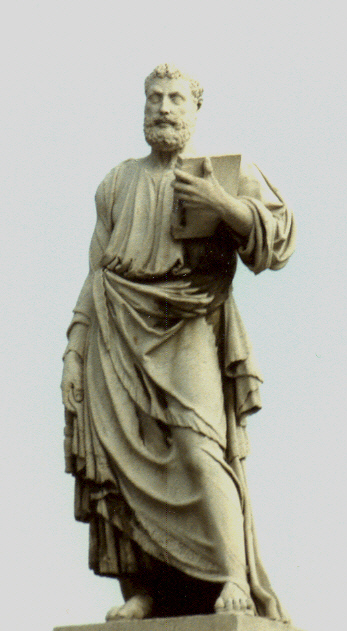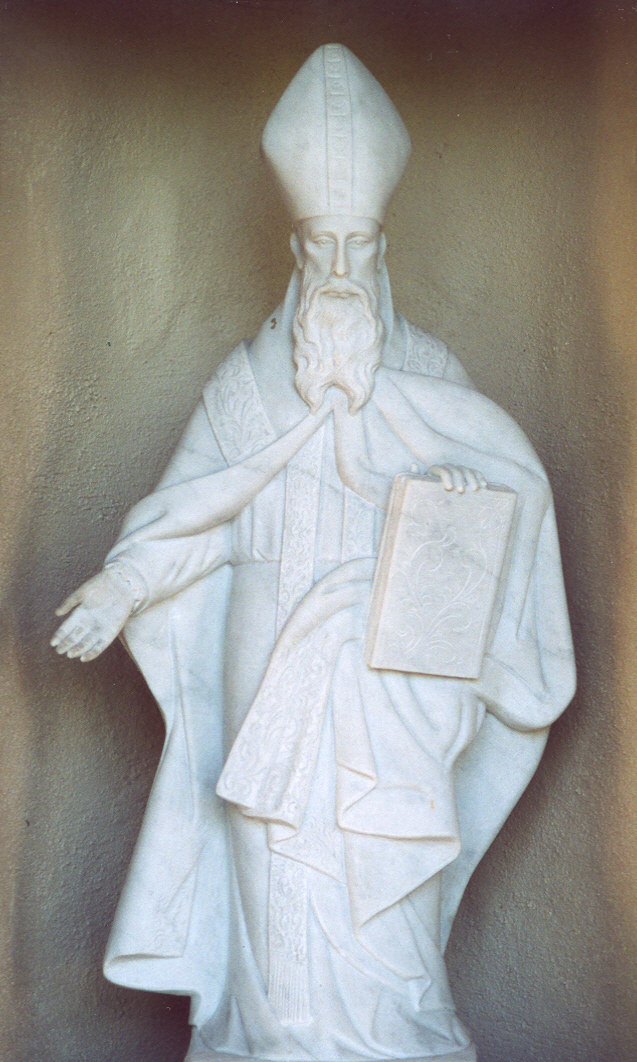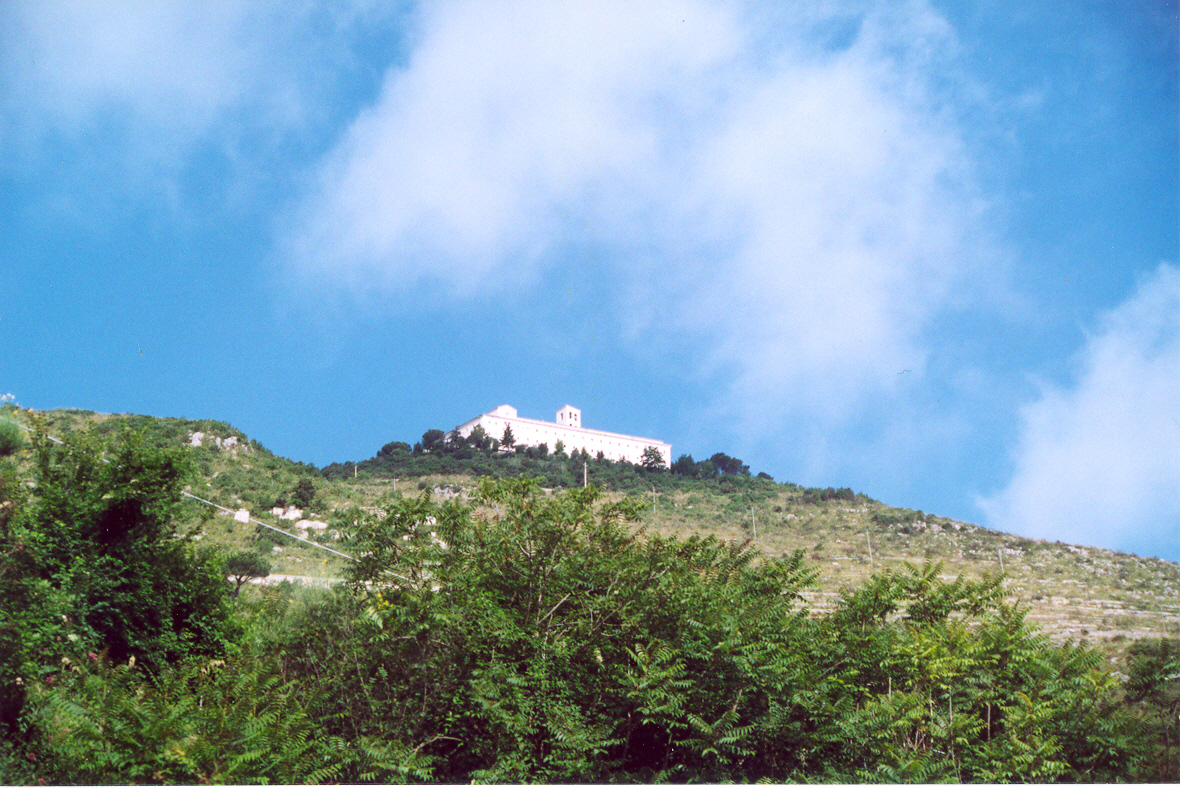
Saints in Our History
The First Thousand Years
Return to
Index The Catholic Faith
Return To
Level Four Topic Index
Home Page
"And his gifts were that some should be apostles, some prophets, some evangelists, some pastors and teachers, for the equipment of the saints, for the work of ministry, for building up the body of Christ, until we all attain to the unity of faith and of the knowledge of the Son of God" (Eph 4:11-13).
Almost two thousand years have elapsed since the founding of the Church and its birth on Pentecost. Although it began as a small community, like the mustard seed in the parable, it has grown and spread throughout the world. During that time it has faced many difficulties and weathered many storms. Yet the Church has survived and is today the same church of which Our Lord spoke when he said to Peter, ". . . on this rock I will build my Church, and the powers of death shall not prevail against it? (Mt 16:18).
The church could not have survived without the constant guidance and protection of the Holy Spirit. In order to preserve the Church, God has raised up many holy men and women who are today recognized as saints. With God's help they have been able to put their various talents and personalities in the service of the Church's special need.
The virtuous lives of these saints are still a source of example and inspiration for us today. Let us now look at a few periods in the Church's history as they are reflected in the lives of some of her greatest saints.
Apostles and Martyrs

The early days of the Church were marked by the apostles carrying out Our Lord's command: "Go therefore and make disciples of all nations" (Mt 28:19). This missionary activity manifests the Church's universality. We have seen that right after Pentecost Peter went out to preach, and by the end of the day three thousand persons were baptized. He was imprisoned, suffered, labored, performed miracles in the name of Jesus, and continued to preach and speak with authority.
Later he went to Antioch and finally to Rome, where he stayed permanently. Peter thus became the first bishop of Rome. He was martyred under the Roman Emperor Nero around the year 64 or 67 A.D. It is said that when they were crucifying him Peter said he was not worthy to die as his Master had died, and therefore he asked that the crucifix be turned upside down. He was buried on the Vatican Hill St. Peter's Basilica was later built over his tomb. Pope St. Linus was elected to succeed him.

The greatest missionary of these early days is the apostle St. Paul. From the time of his conversion, which is described in the Acts of the Apostles, St. Paul preached throughout Palestine, Syria, parts of Asia Minor (modern-day Turkey), Greece, and Rome. During four missionary journeys he zealously preached the good news of Jesus Christ to the Jews and most importantly, to the gentiles (non-Jews). In some places he endured bitter opposition - for example, he was stoned and imprisoned - but still he continued to preach.
In the fourteen letters that he wrote to the communities where he preached, as well as in the accounts of his journeys found in the Acts, we can see St. Paul's great devotion to Christ. Because he so fully carried out Our Lord's command to teach all nations, he is called the "Apostle to the Gentiles". Like many of the early Christians, St. Paul not only lived for Christ; around 68 A.D. he died for him as well, as a martyr.
Although the Church continued her missionary work, the next 250 years were characterized by the persecution of Christians. As their numbers increased, and Christianity spread throughout the Roman Empire, the Roman government began to fear the Church. Under certain emperors over the next two centuries, many Christians were put to death for their faith in Christ. Those who died giving witness to their faith were called martyrs, the Greek word for witness. Many of them were young and only recently baptized, while still others had only heard and accepted the message but had not yet been baptized. Yet they all had one thing in common: they willingly accepted horrible tortures and death rather than deny Christ or his message.
These martyrs were an inspiration both to their fellow Christians and to many Roman citizens. In fact, many people were drawn to the faith after seeing those who willingly died for it. They realized that the Christian faith must be great if so many Christians were willing to give up their lives for its sake. The rapid growth of the Church during this period led one early Christian writer to remark that the "blood of the martyrs is the seed of the Church".
Among those whose blood nourished the Church were two young women who lived in the early third century, St. Perpetua and St. Felicity. Perpetua, a young married woman, was from a wealthy family in Carthage, North Africa. Felicity was a young servant in her household. Shortly after Perpetua gave birth to a baby, she and other members of her household, including Felicity, were arrested because they were Christians. Despite her family's pleas that she give up her faith and return home to her child, Perpetual refused and remained strong.
Felicity, who was awaiting the birth of her own child, was eager to join Perpetua in facing death for Christ. The Roman law, however, would not allow a woman who was with child to be put to death. Because Felicity's child was born soon after her imprisonment, she was martyred along with her mistress and the others who had been arrested with them. The willingness of both Perpetua and Felicity to die for Christ - even though they were young women with children they loved - shows us that they placed God first in their lives.
We honor the memories of St. Perpetua and St. Felicity when we ask their intercession during the Eucharistic prayer of the Mass. We also invoke the intercession of many of the other martyrs here. Among them are the first martyr, Stephen; several early Popes: Linus, Cletus, Clement, and Sixtus; several holy women: Agatha, Lucy, and Cecilia; and the apostles.
In the same way that the early Christians were inspired by the faith of the martyrs, we too look to them as examples of courage. We also can look to the martyrs of our town times. For although the early centuries of the Church were the age of martyrs, we still have many people who have died - are are dying - for their faith.
Fathers and Doctors of the Church
The great age of martyrdom ended in the early fourth century, when the Roman emperor Constantine issued a decree allowing Christians to practice their religion freely. Once this occurred, Christians were able to preach the gospel in the open. Even though the Church was freed from one problem, she soon had to face others. Trouble now came from within the Church in the form of heresies. A heresy is a denial of a basic doctrine of the faith. Those who hold and teach heresies are called heretics.
At the time when Constantine became emperor, a major heresy was being preached in Egypt by a priest named Arius. Arius taught that Jesus Christ, the Son of God, was not of the same nature as the Father. In other words, he said that Jesus was not God.
Because Arius was a forceful speaker and persuasive writer, his heresy, called the Arian heresy, spread rapidly through the Church and even deceived many bishops and priests. Because this heresy denied one of the most fundamental doctrines of our faith, it had to be stopped. The first step was the Church council that met in Nicaea in 325 A.D.
One of the bishops who fought to defend the truth during and after that council was St. Athanasius. Athanasius was the bishop of Alexandria in Egypt, where he defended the teaching of the Church against many Arian forces. He faced several threats to his life and was exiled for his defense of orthodoxy. Despite all of this, he never wavered in defending the truth that the Son of God "one in being with the Father".
Many of Athanasius' writings concern the doctrine he defended throughout his life. On of his books, On the Incarnation, is a treatise on the mystery of the Second Person of the Trinity made flesh. When he died in 373 A.D., Arianism had not been completely conquered. His efforts, however, were not in vain, and Arianism was finally defeated by 381 A.D.

Other heresies, many of which also concerned the nature of Christ, followed the Arian heresy. Saints were raised up to defend the Church against these heresies as well. One of the greatest saints to defend the Church was St. Augustine, who was born near the end of Athanasius' life. Although Augustine became one of the greatest bishops, teachers, and theologians (persons who study and teach about God) in the Church, his early life reminds us that even great sinners who repent can become saints.
Born in North Africa, Augustine was the son of a Roman official and a Christian woman named Monica. During his youth he showed that he had a brilliant mind and was recognized as a great student. In his adolescence, however, he acquired many bad habits and lived a wild life; he seriously broke the Commandment on purity. His mother patiently prayed for him, begging God to give him the grace to accept the faith and reform his life.
Her prayers were answered when, after many years of searching for the truth, Augustine was baptized at the age of thirty-three. Later he became a priest and eventually a bishop. During the remainder of his life he preached many sermons and wrote over one hundred books in defense of the faith. Among these books is his own story of his life and his conversion, The Confessions. Another book, which many consider his most famous work, is The City of God, which contrasts the life of the Christian with the evils of the world in which we must live. Like St. Athanasius, St. Augustine, who died in 430 A.D., is considered one of the Fathers of the Church.
The Monasteries
Later, in the fifth century, barbarian tribes began to threaten the stability of the roman Empire. The barbarians were warlike, uncivilized tribes living in northern Europe outside the boundaries of the empire. As they expanded, they moved south and began invading the empire, once even threatening the city of Rome. The Church recognized the need to convert them to Christianity and to civilize them.
Much of this work was performed during the next three centuries by the monks and the monasteries. Monks were men who lived a life of poverty, chastity, and obedience together in order to serve Christ. They lived according to a specific rule, or way of life, in communities that were usually in remote areas. Here they supported themselves through agricultural activity and dedicated their time to God. Gradually they formed schools at their monasteries. It was through these schools and their later missionary work that the monks were able to Christianize and educate much of Europe.

Although there were monks in the Church as early as the third century, the title of "Father of Western Monasticism" is given to St. Benedict, who was born in 480 A.D. He established the famous monastery at Monte Cassino in Italy and is the founder of the Benedictine order. He composed a rule, which we call the rule of St. Benedict to guide the daily activities of his monks.
Benedict divided the daily activities of his monks into prayer and physical work. This became the motto of all Benedictines: Ora et Labora (pray and work). The daily prayer consisted of the Divine Office - chanted together at seven specific hours of the day and night - and the daily Sacrifice of the Mass. The labor, which was also considered a form of prayer, was both manual - farming, building, and so on - and intellectual - copying of manuscripts, writing books, educating, and the like.
As time passed, the monasteries were not only centers of learning but also missionary centers, from which monks set out to spread the faith. Among these missionary monks was St. Columban, an Irishman who preached the faith among the Franks (living in the area of modern-day France) during the end of the sixth century. Another great example was St. Boniface, a Benedictine monk from England. In the eighth century he left England for the area of Germany. For many years Boniface preached there, spreading the faith and baptizing many from the Germanic tribes.
The Church Faces Problems
While the monks were busy Christianizing the barbarians in Europe, the Church was faced with other invasions as well. A new religion, Islam, had emerged in Arabia early in the seventh century and was now being spread throughout North Africa and the eastern portion of the old Roman Empire. The followers of Islam, called Moslems, eventually gained control of the Mediterranean Sea. As a result, Christians living in western Europe were physically separated from those in the East.
This even intensified problems that had existed for a long time. Christians in the two parts of the empire were divided by language and culture. There had also been a long-running debate over the wording of certain doctrines and over the authority of the bishop of Rome (the Pope). These problems were finally brought to a head in 1054 A.D. In that year, the Church in the East formally separated itself from the Pope and the Roman Catholic Church. This is known as the Eastern schism, or split. While some of the Eastern Christians have been reunited with the Church - for example, the Byzantine Catholics - the schism still exists today.
This schism was only one great problem that the Church faced as it completed its first thousand years. A second was the great corruption of the clergy during the Dark Ages. This period, from about 850 - 1000 A.D., was the result of the gradual collapse of the old Roman Empire. As the Empire collapsed, the Church was the only stable force remaining in the world. Because few laymen were educated, it was left to the clergy to take up the responsibility of governing civil society. Many Church leaders then exercised not only spiritual but temporal power as well.
After a while many bishops, priests, and monks began to forget their roles as spiritual leaders. Unfortunately they became far too concerned with their temporal affairs or their own possessions and lost sight of their primary task. Sad to say, there were even Popes who, though they never taught error, were sinful, corrupt, and worldly. The need for reform of the clergy became more and more urgent. Once again, many saints rose up during the next few centuries to guide the Church through its next crisis.
Used with the permission of The Ignatius Press 800-799-5534
Return to
Index The Catholic Faith
Return To
Level Four Topic Index
Top
Home Page